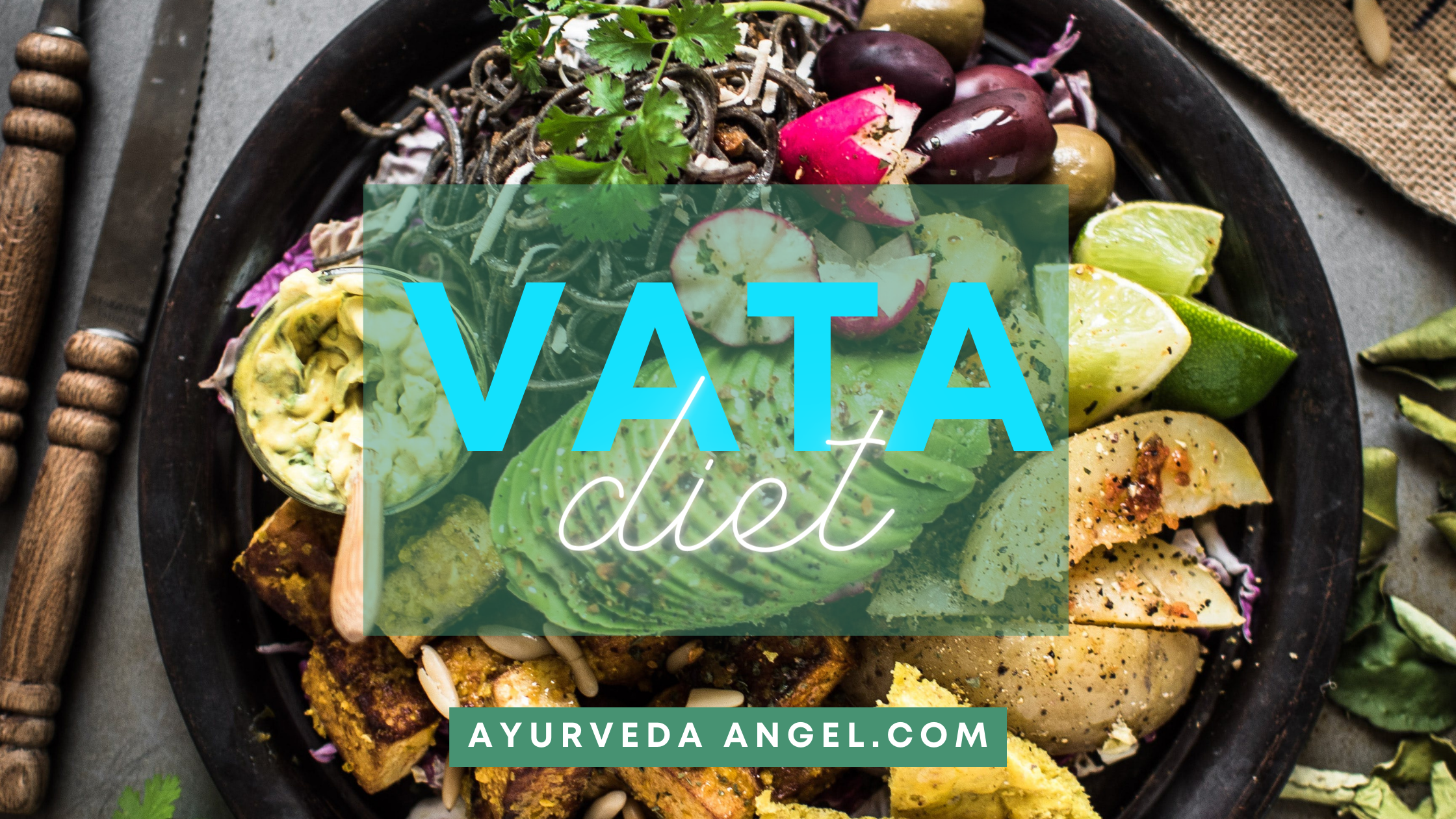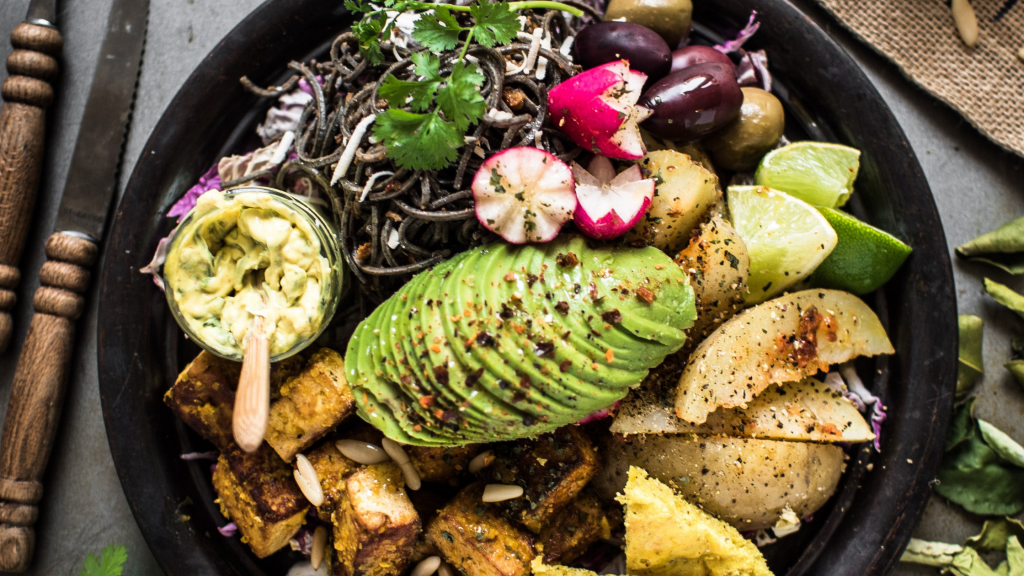If your Vata is feeling a bit out of whack, the first place you should search for the culprit is your diet.
Believe it or not, what we eat and drink—even the herbs and oils we use—has a direct effect on the energy levels of our doshas.
When I started getting into Ayurveda, the first thing I did was start optimizing my diet for my two dominant doshas—Pitta and Kapha.
But I completely forsake my Vata.
To my surprise, I ended up with a Vata imbalance because I was eating way too many cold, dry, and raw foods. So to combat it, I had to rethink my diet all over again.
But after putting into practice a few tips and making sure I was eating the right Vata-pacifying foods, I was able to overcome my rather severe imbalance within a few weeks.
So if your Vata energy is feeling a little excessive—or it’s in perfect balance and you want to know how to keep it that way—this post is for you.

Disclaimer: This blog post contains affiliate links. I may earn a small commission to fund my essential oil shopping spree habits if you use these links to make a purchase. You will not be charged extra, and you’ll keep me supplied in good-smelling oils. It’s a win for everyone, really.
Why Is Eating a Vata Diet Important?
Everything in nature is made out of the five elements, whether it be all five or only one. These elements are:
- Space
- Air
- Fire
- Water
- Earth
Each of the three doshas—Vata, Pitta, and Kapha—are the energies of two elements combined. In turn, those two elements give the dosha qualities.
The elements that make Vata are air and space.
Because of this, Vata’s most dominant qualities are dryness and coolness.
However, when there’s an imbalance in Vata energy, or it becomes excessive, a Vata-dominant person may experience discomfort.
Luckily, there are many ways to treat a Vata imbalance.
And one of the best ways is to optimize your diet.
In fact, if you choose to see an ayurvedic doctor about your imbalance, a diet change is one of the most common recommendations they’ll give you.
So if you want to know exactly how you can begin pacifying your Vata energy through what you eat and drink, keep reading.
What Is a Vata Diet? 7 Tips for Balancing Your Vata Through What You Eat and Drink
First, it’s important to note that consistency is the key to change.
It’ll be very difficult to completely change your diet overnight. First, you’re more likely to get burnt out and fall back into unhealthy habits. Second, drastic dietary changes can be a shock to your system.
The same goes for starting to eat a more pacifying Vata diet.
If you’re new to Ayurveda, it’s best to gradually change the way you eat rather than abiding by a 100% Vata lifestyle on your first day. This will make your transition easier, as it allows you to adapt to the diet as smoothly and easily as possible.
One more quick note before we get started—you’ll notice that the foods you’re supposed to eat are opposite of Vata’s qualities. For example, the first tip is to avoid cold foods and eat warm foods instead.
This is because when your Vata energy becomes imbalanced, it’s excessive.
So when you eat cold foods, it just leads to more coldness. Which leads to more excess Vata energy.
Instead, you want to counter Vata’s qualities.
Imagine you have a scale. The left side is heavier than the right, so the scale will obviously tip to the left. To bring it to balance, you want to place more weight on the right side, not the left. So to balance the scale, you put more weight on the side opposite of the one with too much.
With that said, here’s how you can bring your Vata into balance through optimizing what you eat and drink.
1. Avoid cold foods, favor warm foods
Since one of Vata’s most dominant qualities is coldness, you want to avoid cold foods and drinks.
This means you should do your best to avoid cold beverages, frozen foods, large amounts of raw fruits and vegetables, and the like. Instead, eat foods that are warm either in temperature or energy.
For example, cook your vegetables instead of eating them raw. And eat herbs and spices that pacify Vata, which are warm in energy. (To get a list of Vata herbs, see the last section of the post.)
2. Drink warm liquids
Drinking cold liquids is a big no-no for people with a predominant Vata dosha. However, this doesn’t mean that there isn’t anything tasty left for you to drink.
Two of the best warm beverages are herbal tea and room temperature water with lemon.
Not only will these drinks help you balance your Vata, but both of these beverages are also very relaxing and refreshing!
3. Have a regular eating routine
Choosing the right food to eat is one thing, but tracking how you eat is a completely different story.
By nature, Vata is irregular. So to bring it back to balance, you need to be the opposite—regular.
When on a Vata diet, establish and maintain a regular eating routine.
This means eating three meals a day, at the same time every day. And this doesn’t just apply to food. If you want to take an extra step further, establish a regular sleep schedule as well.
4. Understand the Vata dosha’s composition
The key to a successful Vata diet is understanding which tastes to favor and avoid. And that all relies on Vata’s composition.
We already introduced air and space, Vata’s two elements. And we talked about how the foods we eat should counter Vata’s qualities.
But, what exactly are Vata’s qualities?
Let’s take a look at them now:
- Dry
- Cold
- Light
- Rough
- Mobile
- Clear
- Pungent
- Bitter
If you aren’t familiar with the six tastes of Ayurveda, this list might be a bit confusing for you. But no worries, we’re diving deep into it in the next section!
5. Avoid cold and raw foods, favor hot and warm
Freshly cooked food is the best for pacifying the Vata dosha. Avoid foods that have been refrigerated or are served raw, like sushi and frozen meats.
But raw foods also include vegetables that haven’t been cooked.
So instead of eating a cold, raw meal like salad, try opting for a cooked, warm soup instead.
More examples of warm, cooked foods the Vata dosha loves are:
- Fresh bread
- Warm milk
- Butter
- Stew
- Veggie stir fry
- Cooked tofu
More food suggestions to come later!
6. Eat more oily and moist foods
Dryness is one of Vata’s strongest qualities. Taking this into consideration, you’re going to want to avoid dry foods, as this will wreak havoc on your Vata levels.
To maintain a nice and healthy balance, make sure that most of the food you eat is moist and oily instead of dry.
This will ensure that you keep your Vata levels well managed and balanced.
7. Eat heavier foods rather than light foods
Vata is inherently light, so you can balance this out by sticking to heavier, more whole foods in your diet.
However, it’s also important to understand that heavier foods are usually more calorie-heavy.
Along with establishing a regular eating routine (tip #3), try to manage food intake appropriately and avoid overeating, as overindulgence in food isn’t beneficial for Vata and can lead to a worse imbalance.
The Six Tastes of Ayurveda and a Vata Diet
In Ayurveda, tastes are organized into six different categories:
- Sweet
- Salty
- Sour
- Pungent
- Bitter
- Astringent
Of these tastes, Vata favors sweet, sour, and salty, whereas bitter, pungent, and astringent irritate it.
Keep in mind though that we all need a combination of all six tastes in our lives. So even though bitter, pungent, and astringent foods can irritate Vata, you shouldn’t cut them out completely. Instead, eat them in moderation when your Vata is balanced, and less of them when it’s imbalanced.
Let’s dive a little deeper into each of these tastes.
Sweet
Sweetness is brought about by the elements of water and earth. Like water, sweetness is cold and wet. Like earth, it has some heaviness to it.
To satisfy Vata’s need for sweet, try to incorporate as much of these foods into your diet:
- Dried sugar cane
- Brown sugar
- Ripe fruits
- Pumpkin, sesame, and sunflower seeds
- Nuts (especially almonds)
- Sweet vegetables
- Whole dairy products
Salty
The elements of salty food are water and fire. These elements cause salty foods to give anyone who eats them sensations of moisture and heat.
Salt is essential for life, but like all good things, salt should be taken in moderation.
Too much sodium in your diet can have several nasty effects on your health. Salt, when eaten in responsible amounts, improves digestion, supports muscle growth, and gives you more energy.
The salty foods you can incorporate into your diet are:
- Eggs
- Whole meat
- Black lentils
- All organic oils
- Salt (in moderation)
Sour
The flavor sour comes from the elements of earth and fire. Like the flavors elements, sour foods have a hot but light sensation to them. Sour flavors are very commonly used and very recognizable to most people.
Sour food is known to fuel appetite, stimulate metabolism, increase saliva secretions, and help with digestion. They’re also commonly acidic.
Examples of salty foods are limes, lemons, yogurt, and a lot of fermented goods.
To get your sour in, choose from this food list:
- Whole dairy products (Dairy is both sweet and sour)
- Lemons
- Lime
- Grapefruits
- Pineapples
- Oranges
- Sour Cream
- Kimchi
Pungent
Pungent (otherwise known as spicy) food comes from the elements of fire and air. This type of food gives you that sensation of heat and lightness.
One interesting fact about spicy food is that as humans, we don’t actually have receptors in our tongue that can detect this flavor. Instead, we feel irritation, which gives us the sensation of heat.
Pungent food works wonders for your body. A few benefits from eating pungent foods are helping with digestion, cleansing the mouth, and enhancing other flavors.
Bitter
The bitter taste comes from the elements air and space. Bitter foods have a light, cool, and dry sensation to them, but are often avoided by most people due to the natural taste.
But despite not being liked by many, bitter foods are typically packed with nutritional value. For example, bitter gourd, coffee, and turmeric have multiple health benefits.
Specifically, bitter food is usually known to help stimulate the nervous system, reduce fat, reduce fever, enhance libido, and help with inflammation.
Astringent
The primary elements of astringent foods are air and earth. By definition, astringent foods are slightly acidic or bitter.
If you aren’t familiar with this flavor, imagine a certain food that makes you feel an almost choking sensation upon eating.
Astringent foods tend to numb the tongue and pucker your mouth upon consumption. Most foods that are astringent are unripe fruit.
What Foods Should You Eat on a Vata Diet? The Ultimate Vata Food List
Remember, the Vata dosha favors sweet, sour and salty tastes, and is irritated by astringent, pungent, and bitter tastes.
However, flavors can be confusing sometimes, so to make your life easier, here’s a short list of foods that you should and shouldn’t eat on a Vata diet.
Vata Foods You Should Eat
Dairy
- Warm milk
- Cream
- Butter
Vegetables
- Avodaco
- Beets
- Carrots
- Onions
- Okra
- Shallots
- Sweet Potatoes
- Tomatoes
Viands (Should be fresh)
- Warm soups
- Warm stews
- Chicken
- Seafood
- Fish
- White meats
- Tofu
- Chickpeas
- Beans
- Eggs
Food bases
- Freshly baked bread
- Oats
- Rice
Snacks
- Raw nuts
- Ripe fruits
Drinks
- Herbal tea
- Lemon water
Additives
- Vata herbs
- Sweeteners
- Organic Oils
Foods Vatas Shouldn’t Eat
Dairy
- Frozen yogurt
- High amounts of hard cheeses
Vegetables
- Artichokes
- Asparagus
- Bitter gourd
- Brussels sprouts
- High amounts of raw vegetables
Viands
- Frozen meats
- Highly processed meats
Food bases
- Buckwheat
- Corn
- Rye
Snacks
- Unripe fruits
- Raisins
Drinks
- Softdrinks
- Iced beverages
- Other Carbonated drinks
- Alcohol
Additives
- Safflower
- Carob
In addition to these, it’s also recommended that you avoid margarine, canola, anything that is GMO (genetically modified organisms), and sweeteners that include a lot of fructose.
11 Best Herbs and Oils for Vata
Herbs and oils are gifts from nature for many reasons. For one, even the rare ones are easier to get nowadays thanks to the internet. Secondly, herbs spice up just about any dish and oils can be applied in many different ways.
We talked briefly about how certain herbs are great for pacifying Vata because they’re energetically warm. But what exactly are they and where can you find them?
Each link takes you to the specific herb or product on Ayurvedic Herbs Direct, where you can order it. It’s basically a supermarket for Ayurveda enthusiasts.
Now, let’s get into the list:
- Nasya Oil
- Triphala
- Ashwagandha
- Mahanarayan Oil
- Chyavanprash Jam
- Vata Tea
- Haritaki
- Ginger
- Neem
- Shatavari
- Gokshuradi Guggulu
The purpose of a Vata diet is to bring the Vata energy back into balance.
At first, it might sound intimidating, but once you get the ball rolling, living on a healthy Vata lifestyle becomes easier and easier. Again, diving in 100% right away isn’t always the best thing to do, especially as a beginner.
Instead, get into it slowly. You’ll start noticing the results soon enough, and your Vata will be happy with any little progress you make.
With this short guide, I truly hope that your Vata diet is met with nothing but easy days and success.
Andrew Abad Santos is a Filipino freelance writer, who graduated with a degree in Business Administration from the University of Santo Tomas – the oldest university in Asia. If you wish to contact Andrew for freelance writing or business work, please email him at a.laurelabadsantos@gmail.com

